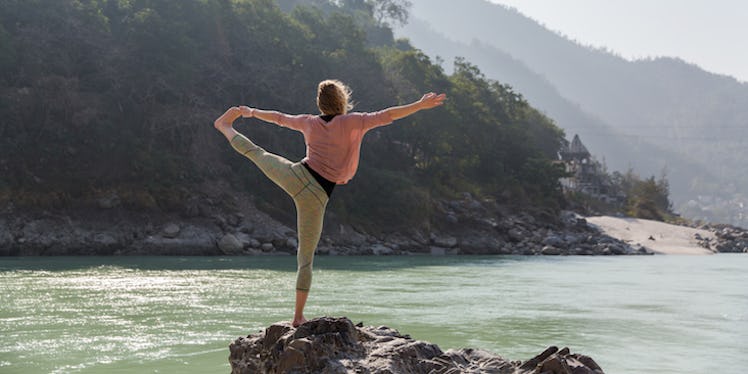
The 6 Yoga Poses You Need To Try For Better Balance & Less Clumsiness
If you're constantly tripping, falling over, or randomly bumping into things, you know the struggle that comes with being an innately clumsy human being. A consistent yoga practice can really help improve your coordination, especially if you're literally known among your friends as the person who has two left feet. Including a variety of yoga poses to improve balance in your routine practice is an easy and fun way to slowly but surely transition from clumsy fumbling to graceful movement in your everyday life.
As a yoga teacher, I constantly encounter people who avoid coming to class because of intimidating balancing poses that they think they'll never be able to achieve, and that can only be done by "advanced yogis" who appear to have it all together. Trust me, this couldn't be further from the truth.
Everyone starts somewhere, and the most challenging balancing asanas are the result of consistent practice, and honing in on mastering the "simpler" poses. Specifically, focusing on the transitions in between poses, and flowing seamlessly from one asana to the next, will vastly help your coordination skills and help you conquer more difficult poses with more ease.
Flow through this sequence, and do your best to go from one pose to the next slowly and with control. It might be quite difficult at first, but after a while you'll get the hang of it — and you'll be the most balanced babe around.
01Mountain Pose (Tadasana)
Begin your practice in a simple, yet powerful mountain pose. This asana may seem incredibly easy, but if you activate the correct muscles and really focus on maintaining slow, even breaths, tadasana is an amazing foundation for every balancing pose within yoga.
Pretend there's a long line of energy shooting out of your head and drawing your body upward, so that your spine is completely straight and strong. Relax your shoulders, engage your legs, and draw in your abdomen. Think about the balance you'd like to achieve both in your physical practice, and in your mental space.
02Chair Pose-Revolved Chair Pose Flow (Utkatasana-Parivrtta Utkatasana)
Slowly sink into a strong and secure chair pose, which is a lower-body strengthener that will help build a foundation of power and sturdiness for transitions throughout the rest of your balancing practice.
Next, begin to twist your arms to the right side of your body, pausing here for a breath in revolved chair pose, and then returning back to center. Repeat this motion on the left side of your body, and then come back to center once more.
Keep on rotating your imaginary chair, syncing each movement with each breath. The fast and heated rotations will greatly improve your coordination skills, and it'll strengthen your glutes and hamstrings in the process, too.
03Half Moon Pose (Ardha Chandrasana)
Gaze a few inches beyond your toes, and lift your right leg behind you as you open your chest and raise your right arm.
This will be a tricky pose for beginners, but if you set your gaze upon a single, non-moving object, it will become easier to maintain your center of balance. If you're staying with your breath, but still can't quite get yourself to stay up, try doing this pose with your back to the wall for a little extra support.
Flex your back foot, and keep your raised leg strong and stable. When you're done holding the pose on one side for a few breaths, repeat the same movement on the other side.
04Tree Pose (Vrksasana)
Return to mountain pose, and prepare to transition into tree pose. Root your right foot firmly into the ground, and raise your left leg to rest on either your calf or your thigh (never your knee).
Again, find that focal point to help you maintain your balance, and bring your hands to heart center as you inhale deeply and exhale slowly.
Once you've finished with one side, begin to work on the other. Remember, one side might be more difficult than the other, and that's totally OK. No one's body is in complete equilibrium.
05Extended Hand-To-Big-Toe Pose (Utthita Hasta Padangusthasana)
As you transition into extended hand-to-big-toe pose, remind yourself that this asana is definitely one of the more advanced balancing poses in the sequence.
Instead of extending your leg all the way out and taking hold of your toe, beginners can try keeping their leg bent and hugging their knee inward, so that the pose won't be so focused on stretching the hamstring.
Breathe expansively, and remember to keep the leg that's on the floor firm and strong. If you're struggling to stay upright, you can also take this pose up against the wall. Once you've completed one side, attempt it on the opposite side for full-body steadiness.
06Eagle Pose (Garudasana)
Return to mountain pose once more, taking a deep, long breath before moving into your eagle pose. Eagle pose, or garudasana, is a great balancing pose because it helps you focus on both your upper and lower body, so that you can begin to acquire total-body coordination.
You can start upright in this asana, and then slowly begin to fold forward, letting your elbows meet your knees, and focusing on achieving a steady balance throughout.
Once you unravel one side of your body, practice eagle pose on the other side. Again, the wall is always available to help you in your beginning stages of any of the balancing poses that you're working on.
If you fall, simply get up and try again, remembering to be kind to yourself and playful in your practice! After all, it's just yoga.